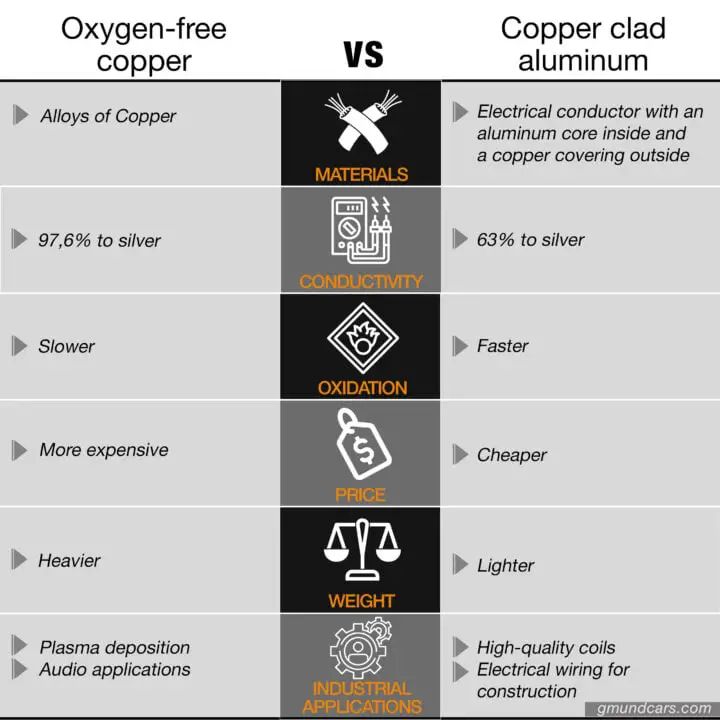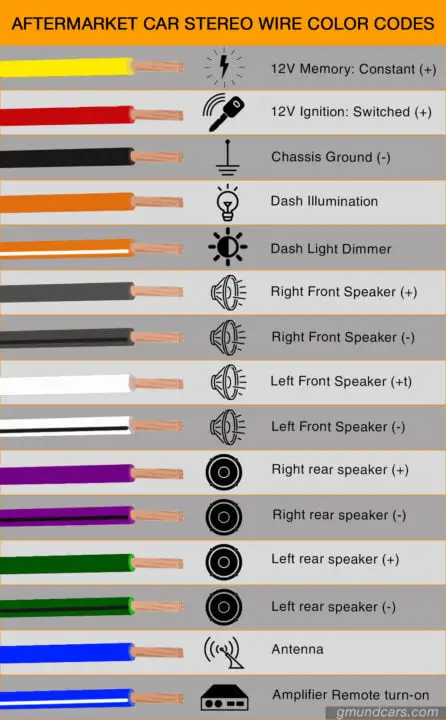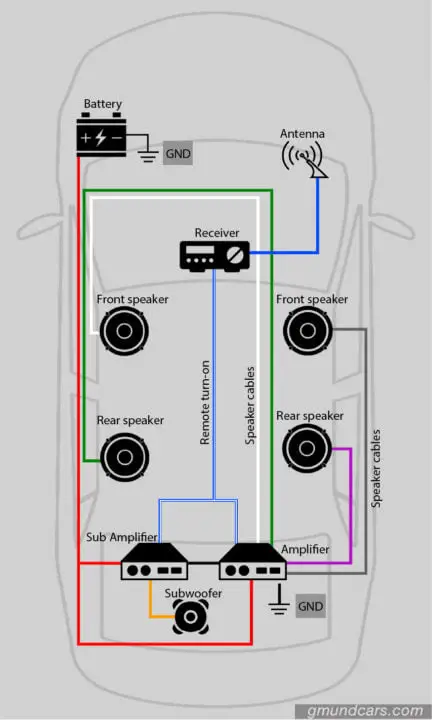When you think about car audio, the complexity of wiring and installation might be the first thing to come to mind. However, that’s not necessarily true. If you have everything you need like wire types, stereo color codes, and a diagram, setting up your car audio can be a simple task.
Need tools for your project? Toolbox, a tool rental marketplace, might be worth a look.
This comprehensive car audio wire guide provides every piece of information that you will need in the wiring. It is also perfect for beginners with no prior experience in this domain.
Well, even if you have had your fair share of knowledge of car audio wiring, you might have faced issues. Now, read this guide to master car audio wire.
OFC vs. CCA
When it comes to car audio, you need to make sure you pick the right kind of wire. There are many types of wire materials that you can consider. Each has its perks and drawbacks.
Even though silver has the highest conductivity, it does not have any car audio wirings applications. The most common types of wiring you will come across are:
- Copper Clad Aluminum or CCA
- Oxygen-Free Copper or OFC
CCA is an electrical conductor with an aluminum core on the inside and a copper covering on the outside.
OFC is made up of high conductivity alloys of Copper with conductivity efficiency close to silver. These alloys are electrically refined. The process allows them to reach a level of oxygen below 0.001%.
Below are the few different aspects that help you distinguish between OFC and CCA’s qualities when choosing wires for car audio.

Conductivity
The conductivity of silver is the highest among all metals. However, it cannot be geared for car audio wiring for numerous reasons. One of them is that silver is an expensive metal, and using silver wires could end up being very costly for any car owner.
CCA wires or wires are one of the most commonly used wires in the industry. They have an efficiency of 63% to silver. So, they are not nearly as efficient as silver, but they do the job well.
OFC is the best alternative to silver when it comes to wiring because the alloys of Copper used in OFC are 97.6% conductive to silver. This high conductivity makes them an ideal choice.
Oxidation
Aluminum wires and CCA will oxidize much faster than OFCs. This will result in them breaking easily and losing their conductance over time.
Price
Aluminum wires or CCA are more cost-efficient alternatives. Copper wires are a little more expensive than brass, aluminum, and nickel wires.
Weight
Aluminum is arguably lighter than Copper. So, when it comes to weight, CCA wires weigh up to 3.324 grams per cubic centimeter. However, OFC is entirely made of alloys of Copper. So, a foot of copper wire weighs about 22.8 grams.
Industrial applications
Apart from car audio wiring, CCA can also be used in other industries. It may not be superior to OFC when it comes to the automobile industry. However, in situations where the wire’s weight is a significant concern, CCA is preferred over OFC. You can see CCA applications in AC wirings and other such appliances.
Aftermarket stereo wire color code
One of the fastest ways to install a car audio system is to understand the wires’ standardized colors. These wires are nothing like the OEM head units. They have uniformity in their colors and can be installed easily by anyone without going through a guide or any paperwork.
Wire color code chart
| Color | Meaning |
|---|---|
| Yellow | +12V Memory: Constant |
| Red | +12V Ignition: Switched |
| Black | Chassis ground (-) |
| Orange | Dash illumination |
| Orange with white stripe | Dash light dimmer |
| Gray | Right front speaker (+) |
| Gray with black stripe | Right front speaker (-) |
| White | Left front speaker (+) |
| White with black strip | Left front speaker (-) |
| Purple | Right rear speaker (+) |
| Purple with black stripe | Right rear speaker (-) |
| Green | Left rear speaker (+) |
| Green with black stripe | Left rear speaker (-) |
| Blue | Antenna |
| Blue with white stripe | Amplifier remote turn-on |
Aftermarket wire colors are straightforward to understand. Once you get the hang of it, you will not need any guidance to set them up. Aftermarket car stereo wires use individual wires for power, antenna, speaker, and ground wires. Be sure to check for the different colors before installing it in your car.
Below is an uncomplicated guide to understanding the different car head unit wire colors.

Popular aftermarket brands like Kenwood, Pioneer, Alpine, Sony, Clarion use the same color code for uniformity in the product.
Car audio wire diagram

Wiring diagrams make it very easy for you to set up or install a car audio system. Once you understand the different color codes of the audio wires used in cars, this task becomes all the more convenient to carry out.
The colors of the wires are the only thing to pay attention to. Apart from this, it would be best if you also were very careful of the terminals of the wires while you install them.
Wire size
If you are setting up an elaborate audio system for your car, you might need more than just one wire size. Different wires are used for various elements and speakers in the car. However, first, you need to know about the basics of car audio wire sizes.
What is the gauge?
The gauge of a wire generally refers to its size. Wires of different sizes perform different tasks. So, wires of different thicknesses are classified into meters. Higher gauge wires are usually thin, and wires with a small gauge are on the thicker side.

ZeeDix Wire Gauge Measurement Tool
The most common standard for measuring the wire’s size is the American Wire Gauge system or the AWG. It was established in 1857 and has been crucial for determining the different wire sizes around the globe.
This wire gauge system is also known as the Brown and Sharpe wire gauge system. It is used as a standardized system that classifies wires based on their diameters.
AWG wire sizes table
| AWG size | Conductor Diameter (Inches) | Conductor Diameter (mm) | Resistance/Length (mΩ/m) | Resistance/Length (mΩ/ft) |
|---|---|---|---|---|
| 0000 (4/0) | .460 | 11.68 | .161 | .049 |
| 000 (3/0) | .409 | 10.40 | .203 | .062 |
| 00 (2/0) | .365 | 9.27 | .256 | .078 |
| 0 (1/0) | .325 | 8.25 | .322 | .098 |
| 1 | .289 | 7.35 | .407 | .124 |
| 2 | .258 | 6.54 | .513 | .156 |
| 3 | .229 | 5.83 | .647 | .197 |
| 4 | .204 | 5.19 | .815 | .249 |
| 5 | .182 | 4.62 | 1.028 | .313 |
| 6 | .162 | 4.12 | 1.296 | .395 |
| 7 | .144 | 3.67 | 1.634 | .498 |
| 8 | .129 | 3.26 | 2.061 | .628 |
| 9 | .114 | 2.91 | 2.599 | .792 |
| 10 | .101 | 2.59 | 3.277 | .999 |
| 11 | .091 | 2.31 | 4.132 | 1.260 |
| 12 | .081 | 2.05 | 5.211 | 1.588 |
| 13 | .072 | 1.83 | 6.571 | 2.003 |
| 14 | .064 | 1.63 | 8.286 | 2.525 |
| 15 | .057 | 1.45 | 10.45 | 3.184 |
| 16 | .051 | 1.29 | 13.17 | 4.016 |
| 17 | .045 | 1.15 | 16.61 | 5.064 |
| 18 | .040 | 1.02 | 20.95 | 6.385 |
| 19 | .036 | .91 | 26.42 | 8.051 |
| 20 | .032 | .81 | 33.31 | 10.15 |
| 21 | .029 | .72 | 42.00 | 12.80 |
| 22 | .025 | .64 | 52.96 | 16.14 |
| 23 | .023 | .57 | 66.79 | 20.36 |
| 24 | .020 | .51 | 84.22 | 25.67 |
| 25 | .018 | .46 | 106.2 | 32.37 |
| 26 | .016 | .41 | 133.9 | 40.81 |
| 27 | .014 | .36 | 168.9 | 51.47 |
| 28 | .013 | .32 | 212.9 | 64.90 |
| 29 | .011 | .29 | 268.5 | 81.84 |
| 30 | .010 | .26 | 338.6 | 103.2 |
| 31 | .0089 | .23 | 426.9 | 130.1 |
| 32 | .0079 | .20 | 538.3 | 164.1 |
| 33 | .0071 | .18 | 678.8 | 206.9 |
| 34 | .0063 | .16 | 856.0 | 260.9 |
| 35 | .0056 | .14 | 1079 | 329.0 |
| 36 | .0050 | .13 | 1361 | 414.8 |
| 37 | .0045 | .11 | 1716 | 523.1 |
| 38 | .0039 | .10 | 2164 | 659.6 |
| 39 | .0035 | .09 | 2729 | 831.8 |
| 40 | .0031 | .08 | 3441 | 1049 |
Why is the wire size important?
The size of the wiring you use has a lot of significance in your car audio because the different types of wires are used for many other components. Each wire has a different set of abilities that need to be utilized accordingly.
The kind of speaker you buy depends on the wires you use. Thicker wires or wires with a lower gauge are geared toward amplifiers or subwoofers in the car. On the other hand, higher gauge wires or thin wires are designed for tweeters, speakers, and crossovers. All the wires you choose must follow the AWG.
This makes it easier for you to connect and add speakers to your audio system without much confusion. You will find that most of the wire gauges available in the market range from 22 gauge to 10 gauge.
How to choose the right wire size for your car audio systems?
As mentioned earlier, the wires you choose help you determine the kind of speakers you will be using in your car audio system. Lower gauge wires are used for amplifiers or subwoofers, and higher gauge wires or thinner wires are geared for speakers.
If you are installing car speakers that are not too powerful, you can opt for 18 gauge wires for your car. This standard wire is the most popular among users and is widely bought for car audio systems. This wire works great for about 50W for 4-ohm car speakers.
If you want to install more powerful speakers in your car, you might want to choose something with a lower gauge. You can get a 16 gauge wire for more power output. Moreover, you can use 14 gauge wires if you are installing subwoofers and amplifiers in your car.

Note: The above chart is only right for the Copper wire.
Additionally, if you are using longer lengths of wires, it is advised you opt for lower gauges. This is because longer wires face a more considerable amount of resistance. A wire with a lower gauge will help you mitigate this problem and give you a high-quality sound output.
Wire installation tips & tricks
If you are a beginner, car audio installation may seem like a daunting task to you. However, with the right knowledge and a little guidance, you will have no trouble installing it. Here are a few tricks that will help you install the sound system in your car.
Wire temperature & jacketing
Wires can carry a large amount of energy that could dissipate as heat. When this happens, anything that comes in contact with this heat will be set ablaze. Wire jacketing is done to avoid such mishaps. Covering the wire with an insulating material helps avoid this dissipation outside, and it also prohibits moisture or chemicals from entering the wire.
Routing wire
It is advised that you route the ground wire to the amplifier of your car audio system. You can go ahead and hook the 18 gauge wire up. This is done to reduce any extra noise in your sound system.
Running signal wires
Signal wires are essential as they provide signals to the amplifier that enable it to tune into channels. First, you will need to figure out how many audio tracks you need. After this, you can use an 18 gauge wire for the signal wire. This will run along with the primary wire in the car.
FAQs
1. What happens if you mix up positive and negative speaker wires?
When you mix up positive and negative speaker wires during installation, you observe a very faint and thin sound. You will not hear the music’s bass properly and even experience degradation in midrange tones. This reversal will not affect or damage your speaker in any way.
2. What happens if speaker wires are backward?
If you have only one speaker and it is reversed, you will not experience any sound changes. There will be a slight difference but no severe change in the quality or the output. However, if you have a pair of speakers, you will need to reverse both of them to hear the perfect sound.
3. Can speaker wires cause a fire?
The chances of your speaker wires causing a fire are exceptionally low. This is because these wires do not carry high voltages. Moreover, most amplifiers come with a protective feature that shuts the amplifier off in the care of a short circuit. So, there is very little chance of speaker wires causing a fire but make sure you are still careful while handling them.
4. How do I know if my speaker wires are bad?
Bad speaker wires generally have frayed ends and keep detaching themselves from their terminals. You will also notice a degraded quality of sound because of this.
Final Thoughts
Choosing the right type of wire for your car audio will make all the difference. With the help of this guide, you will know exactly what your car needs and how you can make your audio system sound exquisite! So, make sure you read it through and master car audio wire in absolutely no time!